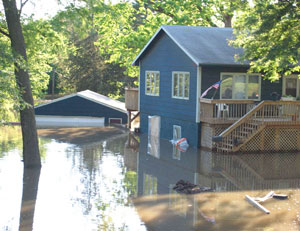

Vol. 72/No. 26 June 30, 2008

|
| Militant/Frank Forrestal |
| A levee in Des Moines, Iowa, burst June 14, flooding Birdland, a working-class neighborhood. |
Family farmers facing big losses to their crops and other rural residents have been devastated by the social disaster. Owners of agribusinesses are predicting higher corn and soybean prices, which will add to the economic squeeze on working people.
Much of the Midwest, in particular Indiana, Illinois, Minnesota, and Wisconsin, also faces higher than usual seasonal flooding and damage to agriculture.
In Des Moines an outdated levee—which authorities knew for more than a decade was a disaster waiting to happen—burst in the working-class neighborhood of Birdland.
In a display of solidarity, thousands of working people across the state turned up to help sandbag wherever needed. Boats traveled the streets of flooded towns ferrying residents to safety.
Small farmers have been particularly hard hit. The losses from the flooding and bad weather are likely to exceed $2 billion, Iowa governor Chet Culver reported.
Driving up the road to Marshalltown, an hour from Des Moines, many farms looked more like rice paddies then cornfields. The drier land is still waterlogged and corn that is usually almost waist-high by this time of year is so stunted it barely stands ankle-high, due to earlier storms.
More than a million acres of corn have been washed out, along with 2 million acres of soy beans. The Iowa Farm Bureau estimates up to 20 percent of Iowa’s grain crops may be lost.
Hog farms, which rely on corn for feed, and cattle ranches, which require hay, will also be hard hit. Many farmers have not been able to harvest hay due to the wet conditions.
Nancy Degner of the Iowa Beef Industry Council predicted that “herds will be reduced and the supply of meat will be lower. Food prices will go up.”
Hardest hit was eastern Iowa. Cedar Rapids ordered the evacuation of 25,000 residents and the hospital.
Flood levee bursts
During the 1993 flood of parts of Des Moines, city residents lost access to drinking water for 12 days. Over the following 15 years millions of dollars were used to build up levees and increase flood control protection of the downtown business district.
On June 14, a 100-foot-wide section of the levee protecting the Birdland working-class neighborhood burst and a mandatory evacuation order was issued for the area. More than 200 homes and the high school there were flooded.
According to the Army Corps of Engineers, the levee was poorly compacted when it was built in the 1950s and was further weakened over the years by tree roots. Corps officials had predicted after the 1993 flood that the levee would not hold without major improvements.
Roger Less, a Corps spokesperson, said that last December U.S. Congress authorized rebuilding the Birdland levee. Asked why this was not done, he replied, “When you’re a nation at war, things tend to take a little longer on the home front at times. Priorities are stretched.”
Charles Pickett, 71, unable to sandbag because of his bad knees, used his boat, pickup, and car to help move families in the Birdland area. “It looked like they needed help,” he told the press.
In Iowa City, an army of University of Iowa students and others moved books from the library to higher ground and helped sandbag and build a levee to try to protect the buildings.
Front page (for this issue) |
Home |
Text-version home